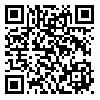Volume 13, Issue 2 (July 2006)
J Birjand Univ Med Sci. 2006, 13(2): 9-15 |
Back to browse issues page
Download citation:
BibTeX | RIS | EndNote | Medlars | ProCite | Reference Manager | RefWorks
Send citation to:



BibTeX | RIS | EndNote | Medlars | ProCite | Reference Manager | RefWorks
Send citation to:
Nakhaei M, FaragZadeh Z, Tabiei S, Saadatjoo S, Mahmoodi Rad G, Hoseini M. Evaluation of ergonomic position during work in nurses of medical and surgical wards in Birjand University of Medical Sciences hospitals. J Birjand Univ Med Sci. 2006; 13 (2) :9-15
URL: http://journal.bums.ac.ir/article-1-93-en.html
URL: http://journal.bums.ac.ir/article-1-93-en.html
1- Instructor, Faculty of Nursing and Midwifery, Birjand University of Medical Sciences. Birjand, Iran , maryamnakhaee@bums.ac.ir
2- Instructor, Faculty of Nursing and Midwifery, Birjand University of Medical Sciences. Birjand, Iran
3- B.Sc, Birjand University of Medical Sciences. Birjand, Iran
2- Instructor, Faculty of Nursing and Midwifery, Birjand University of Medical Sciences. Birjand, Iran
3- B.Sc, Birjand University of Medical Sciences. Birjand, Iran
Abstract: (22063 Views)
Background and Aim: Musculoskeletal disorders may induce by occupational injuries in nurses during work. Assessing work activities by postural analysis in different nursing tasks can identify the hazardous aspects of the job that can be changed by alternative methods to decrease these hazards. The aim of this study was ergonomic evaluation of working postures of nurses and musculoskeletal disorders among them.
Materials and Methods: In this cross-sectional study all registered nurses in Medical- Surgical wards of Birjand University of Medical Sciences hospitals-Imam Reza and Valiyye Asr- in 2005 were selected. Data was collected using Nordic questionnaire and Rapid Entire Body Assessment (REBA) checklist of 6 more common working postures in nursing. REBA risk level and necessary action were determined by REBA software .Then, the data was analyzed by descriptive and analytic tests.
Results: From 43 nurses assessed 95.3% were females whose mean age was 34.8±5.94 years. 58.1% had B.Sc. Degree and 41% had less than a 5 year work experience. Most musculoskeletal disorders were in the legs (62.8 %) and low back (53.5%). The most probable cause for their disorders was found to be their working condition. In REBA assessing, although all tasks were in moderate risk level, the score was 8 or more, which necessitated taking action when patient handling was done.
Conclusion: According to the obtained results, in educational programs, teaching nurses on body mechanics, and changing the physical demands of the job (using an ergonomic approach) through using assistive devices) must be taken into account.
Materials and Methods: In this cross-sectional study all registered nurses in Medical- Surgical wards of Birjand University of Medical Sciences hospitals-Imam Reza and Valiyye Asr- in 2005 were selected. Data was collected using Nordic questionnaire and Rapid Entire Body Assessment (REBA) checklist of 6 more common working postures in nursing. REBA risk level and necessary action were determined by REBA software .Then, the data was analyzed by descriptive and analytic tests.
Results: From 43 nurses assessed 95.3% were females whose mean age was 34.8±5.94 years. 58.1% had B.Sc. Degree and 41% had less than a 5 year work experience. Most musculoskeletal disorders were in the legs (62.8 %) and low back (53.5%). The most probable cause for their disorders was found to be their working condition. In REBA assessing, although all tasks were in moderate risk level, the score was 8 or more, which necessitated taking action when patient handling was done.
Conclusion: According to the obtained results, in educational programs, teaching nurses on body mechanics, and changing the physical demands of the job (using an ergonomic approach) through using assistive devices) must be taken into account.
Type of Study: Original Article |
Subject:
Occupational Health
Received: 2006/09/6 | Accepted: 2016/03/10 | ePublished: 2016/03/10
Received: 2006/09/6 | Accepted: 2016/03/10 | ePublished: 2016/03/10
Send email to the article author
| Rights and permissions | |
 |
This work is licensed under a Creative Commons Attribution-NonCommercial 4.0 International License. |




